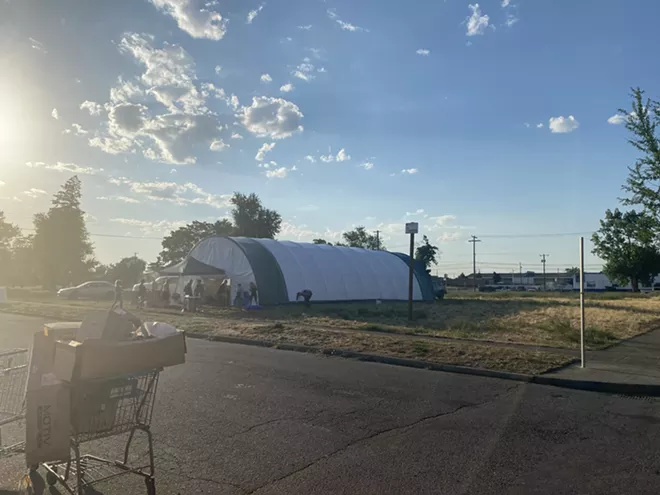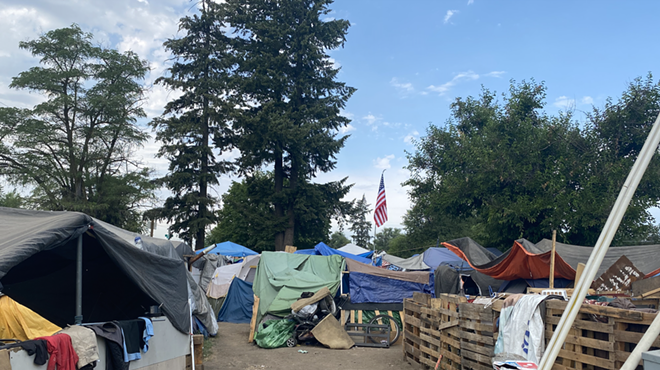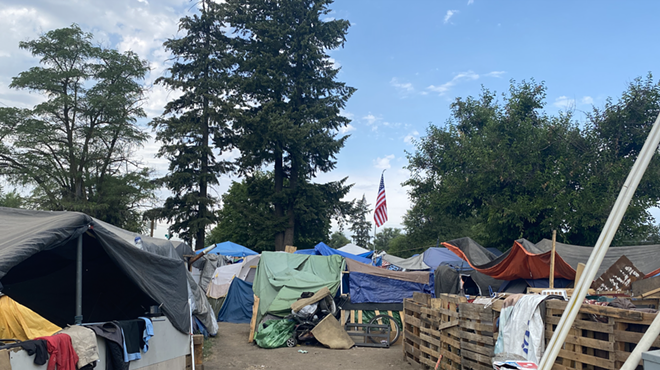click to enlarge

Nate Sanford
On Thursday evening, unhoused people took shelter from the 104 degree heat inside Camp Hope's cooling shelter.
On Wednesday, the Spokane Fire Marshal ordered the Washington State Department of Transportation (WSDOT) to remove a cooling shelter at Camp Hope — a homeless encampment of more than 600 people that is located on WSDOT property near Interstate 90 in Spokane.
As a heat wave sent Spokane temperatures soaring above 100 degrees, the order demanded WSDOT remove the cooling shelter by 9 am Monday, or the agency would face a daily fine of $536. WSDOT is still deciding how to respond.
The Camp Hope cooling shelter was erected by volunteers on Tuesday and Wednesday. Like Camp Hope itself, the shelter has not received approval from WSDOT and is technically illegal. However, WSDOT indicated earlier this week that it would not be doing anything to stop the shelter because of humanitarian reasons.
“We are not interested in hurting people,” Joe McHale, a communications consultant with the WSDOT Eastern Region, tells the
Inlander.
But then came the city’s order. Now WSDOT isn’t sure what to do.
On Thursday afternoon, McHale said WSDOT was reviewing the notice and having an “ongoing discussion about what the next steps will look like.” McHale noted that the state agency does not have enforcement power. They haven’t made any final decisions, but if they decide to comply with the city’s order, they would need to rely on local law enforcement to actually make it happen. McHale says the agency will have a decision before the city’s Monday deadline.
“We are hopeful that this ends up having a positive outcome, a better outcome for everyone,” McHale says.
In the notice of violation sent on Wednesday, Lance Dahl, the Fire Marshal, told WSDOT that the agency has a “legal responsibility to secure the property from illegal construction activity” because they are the owners of the property the structure is occupying.
The order cites the International Fire Code section 106.7.25, which relates to membrane structures and tents. When reached by the
Inlander on Thursday afternoon, Dahl said he was not commenting on the matter, and that the structure’s lack of approval from the property owner made an order to remove it necessary.
Construction of the cooling shelter began on Tuesday. About a dozen volunteers worked to help assemble it. The tent itself is owned and operated by Jewels Helping Hands, a nonprofit that has been working to organize supplies and other assistance for the camp. The tent is large: 65 feet long and 15 feet tall. There are 30 cots inside.
Fire Marshal Dahl visited the tent when it was still under construction on Tuesday. Julie Garcia, the Executive Director of Jewels Helping Hands, says the tent’s internal structure was finished after just one day, but they waited to put the canopy on because they didn’t want people going inside until the fire department had a chance to inspect it.
Garcia says organizers filled out a permit application at Dahl’s request. Shortly after, she remembers Dahl telling her that they actually didn’t need a permit.
On Tuesday, Garcia says Dahl did a walkthrough of the shelter and checked to make sure there weren’t too many tables, chairs or other fire hazards inside. Dahl also gave them an occupancy limit of 150 and asked that they get a fire extinguisher, according to Garcia. After getting a fire extinguisher, Garcia remembers being told it was okay to open up the shelter.
“We didn’t let anyone in until they said it was okay,” Garcia says.
The city’s telling is slightly different. This is what Kirstin Davis, the city’s communications manager, said in an email to the
Inlander:
“The SFD Fire Marshal visited the site and outlined the items that need to be in place in order for a permit to be issued. The City was notified that WSDOT is not in support of the activities happening on the property, and are not taking action to trespass any occupants. Without authorization of activities by a property owner, the City, by law, cannot issue a permit.”
A series of emails obtained by
RANGE Media on Thursday show City Attorney Lynden Smithson detailing a plan to request WSDOT remove the shelter. In an email sent to city leaders, Smithson said the administration “does not want the encampment to expand and at City Legal we have some concerns for liability with the tent that has been erected.”
According to RANGE, Smithson was responding to an email Council member Michael Cathcart sent to Smithson and City Administrator Johnnie Perkins Thursday morning, which asked them to address “legal questions and precedence concerns” involving the shelter.
click to enlarge

Nate Sanford
The tents occupied by many Camp Hope residents can trap heat and become dangerous during heat waves.
On late Thursday afternoon, while WSDOT contemplated their next steps, Camp Hope was sweltering.
More affluent Spokane neighborhoods like South Hill have dense tree canopies that help block out the sun and provide a bit of welcome relief from the heat. Camp Hope — located on a barren block of WSDOT land adjacent to I-90 in the east end of Spokane’s East Central neighborhood — has only a couple trees. It’s mostly dead grass. The asphalt sucks in the sun and radiates it back at you in waves.
By 6:45 pm, temperatures were just starting to creep below 100. Despite the heat, many of the camp’s residents seemed to be in good spirits — there was laughter and people sitting on a truck strumming an acoustic guitar. Inside the cooling shelter, people lounged on cots trying to catch a break from the sun. Volunteers carried large packages of ice and passed out bottles of water and Gatorade. At the shelter’s entrance, misters blasted people with a refreshing spray of water. The city isn’t supplying water, so Garcia says they've been relying on neighbors who let them borrow their hoses.
“Why are we the people supplying water?” Garcia says. "That makes no sense.”
Garcia says organizers have already been through three pallets of water and about 400 pounds of ice. Jewels Helping Hands has a second, identical structure that could be set up as a cooling shelter if needed, but she says the current one has yet to reach capacity and they don’t know if it will be needed.
Garcia is frustrated by the city’s lack of help.
“[The city] always wants to find common ground,” Garcia says. “I have a hard time finding common ground with people who don’t care about the humanity of their citizens.”
The cooling shelter at Camp Hope closes at 8 pm and reopens in the morning. As the evening went on, the heat became more bearable. A flow of people started leaving the cooling shelter and wandered back to their tents to cook dinner.
Spokane saw 20 confirmed deaths in last year’s record-breaking heat wave, which saw temperatures as high as 109 degrees — the highest ever recorded in the area.
Temperatures this year aren’t expected to get much higher than 104, but that’s still dangerously high — especially for people living outside without easy access to shade and water. The tents many unhoused people sleep in can trap heat and make the situation even more dangerous.
“It’s hotter in the tent around this time of day than it is outside,” says Karen Potter, who lives in a tent in Camp Hope with her husband. Potter has type two diabetes and says frequent trips to the cooling shelter have helped make the heat more bearable. She, too, is frustrated by the city’s lack of action.
“The politicians at the city think because we aren’t paying property tax, rent, water, sewage, garbage … cable, and landline and all that — that we deserve to sit out here and die,” Potter says.
click to enlarge

Nate Sanford
The cooling center at Camp Hope has fans, water misters and space for 150 people.
Last year, Spokane City Council passed an ordinance requiring cooling centers to open anytime the temperature is projected to pass 95 degrees for two days in a row or longer. On Monday, the city extended the hours of four public library buildings so they could serve as cooling shelters. Several community nonprofits have also set up cooling centers of their own, and the city has also directed people to use the city splash pads.
Temperatures are expected to remain above 100 this weekend before dipping to a high of 95 degrees on Monday. A group of community members and nonprofits called Cool Spokane has urged officials to open cooling centers anytime the temperature reaches 85 degrees or higher for two days in a row or longer. In a letter sent to the city, the group says the current response is inadequate.
“While we have seen improvements following 2021’s updates to the human rights ordinances, we continue to see gaps that need to be filled now and in the future, and we believe that these changes can significantly decrease serious injuries and deaths due to inclement weather in Spokane,” the letter says.
Garcia is frustrated with the city and thinks the library cooling centers are insufficient. The nearest library to Camp Hope is Liberty Park, about a mile away. The Spokane Transit Authority has said people can take the bus for free if they tell drivers they are on their way to a cooling center, but Garcia says the city hasn’t done a good job communicating that. Some residents also have mobility problems that prevent them from making the trip.
The bigger problem, Garcia says, is that most residents aren’t willing to leave their tents for that long. Many people have pets, or are concerned their possessions will be stolen if left unattended in their tent.
“If you live in that tent right there and you were afraid of the other 600 people stealing your things… I wouldn’t leave either,” Garcia says. “And the scary thing is then you risk death.”
In a statement to the
Inlander, Davis cited concerns about the cooling shelter’s fire readiness.
“The City and its leadership are very concerned that an occupant could be injured or there could be a serious fire event at the site causing mass casualties,” Davis says.
Davis went on to say that the goal of the removal order is to balance compliance with existing health and safety laws and the “risk the City and its taxpayers are undertaking with the untenable situation on the WSDOT property.”
Camp Hope is located on a block of WSDOT land adjacent to the freeway. The entire block is now covered in tents, so the cooling shelter was set up on another unoccupied block across the street that is also owned by WSDOT.
In an email sent to council members on Wednesday night, Council President Breean Beggs said it sounds like the cooling shelter would comply with the Fire Marshal’s rules, but that Dahl would not be able to sign off on it until he got confirmation that landowner — WSDOT — signed off on the tent.
“I have asked Interim City Attorney Smithson to work closely with Council to support us in trying to protect the health and safety of vulnerable residents and he has agreed to do so,” Beggs said in the email. “Chief [Brian] Schaeffer remains very concerned about the health of Camp Hope residents but is required to follow the instructions of the Administration.”
Fire Chief Schaeffer directed the
Inlander’s request for comment to Davis.
After news of the city’s order broke late Thursday night, Garcia said in a Facebook post that the shelter is made of fire resistant canvas and has a very low chance of mass casualties. The tent is not enclosed, per the fire department’s recommendation. She said there is no smoking in the structure and that grass and weeds surrounding the cooling shelter were removed on the day it was set up.
On Thursday evening, Garcia said she was confused about the city’s order and hadn’t heard anything about it from officials. She doesn’t understand why they would want to take it down.
“It’s unreasonable, like, why would you fight this? This makes no sense. It’s not costing anybody anything. The community is literally donating everything,” Garcia said. “No one’s sleeping in it. No one’s camping in it. It is just keeping them cool during the day and then it shuts down in the evening. What’s the problem? I don’t understand.”
The cooling shelter appears to be working so far. Garcia says — with lots of pride — that there were zero ambulance calls on Thursday. She’s worried about people dying like they did last summer, but so far everyone has managed to stay mostly healthy.
On Wednesday, Matthew Lawson, a Camp Hope resident, noticed one of his neighbors in the camp having a heat stroke. He used a cold towel and gave the person breathing instructions to help nurse them back to health. He used to live in Vegas and is used to the heat; he’s had several heat stroke incidents himself and knows how to look out for warning signs. He says the current heat is nothing compared to what he dealt with back in Nevada, but he worries about others who don’t have as much experience. He’s not sure what the camp would do without the cooling shelter.
“I just think that it’s an extra blessing from the Lord Jesus Christ,” Lawson says. “The help from [Julie] and her team, all that she’s been doing and all the hard work, I just think it’s amazing. Because not many people think about the broken.”































